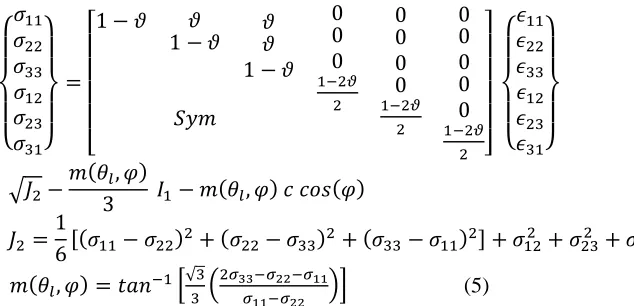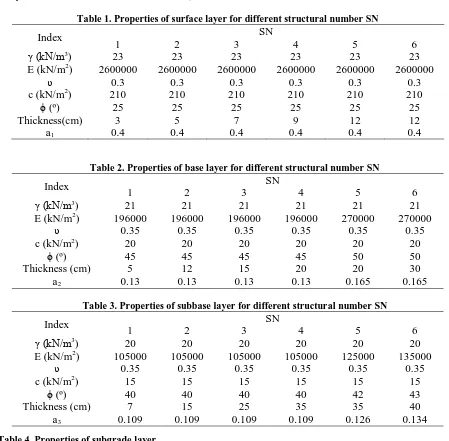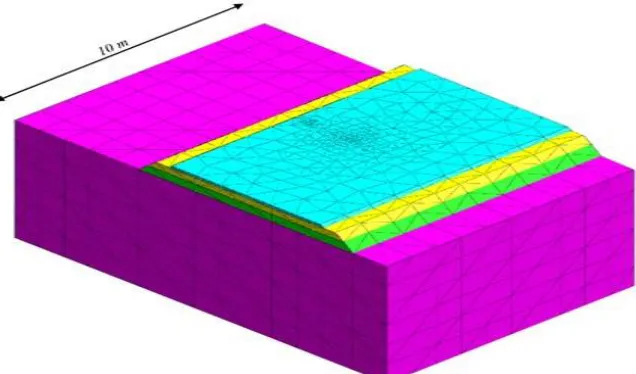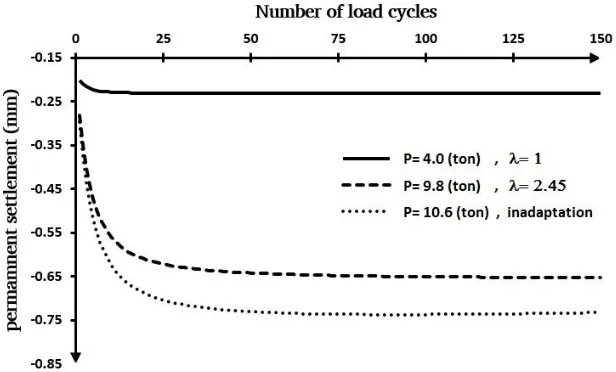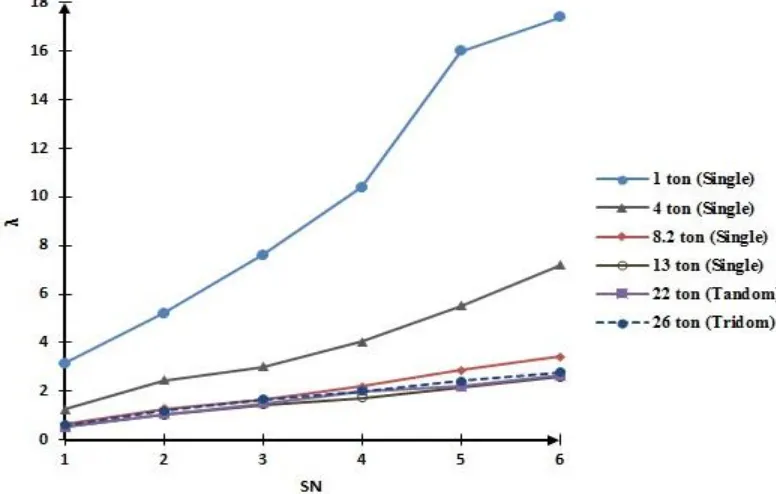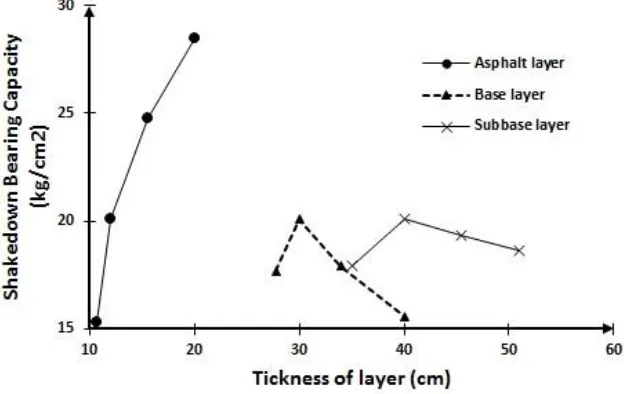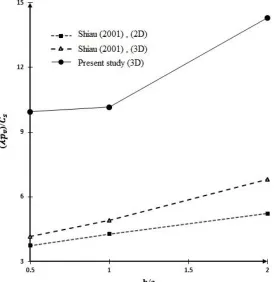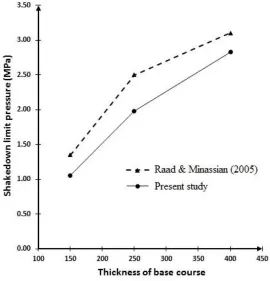Elasto-Plastic Finite Element Evaluation of Flexible
Pavements Based on Shakedown Concept
Mohammad Reza Arvin1, Mehdi Tamiz2
Received: 22. 11. 2016 Accepted: 30. 07. 2017
Abstract
In this paper, three-dimensional elasto-plastic finite element analysis was performed on flexible pavements under vertical repeated traffic loads to evaluate their shakedown behavior. Six different pavements with different structural number (SN) were modeled and subjected to a wide range of cyclic vehicle loads. Shakedown limits were obtained considering both failure and serviceability restraints. Results indicate that shakedown coefficient and shakedown bearing capacity increase with a rise in SN for all load types. Lower limit of shakedown bearing capacity versus SN can be regarded as a criterion for pavement design. Besides, shakedown failure-displacement factor (SFDF) was introduced as an index which is able to include both failure and serviceability criteria to compare pavements in terms of their shakedown behavior. Results suggest increase in SFDF with increasing SN, particularly for light loads. Furthermore, results indicate that increase in asphalt layer thickness always improves shakedown bearing capacity, while increase in base and subbase layer thickness is not only ineffective beyond an effective thickness but may also be damaging. In addition, the results of the present study were compared to lower bound and upper bound shakedown analysis for verification and showed reasonable agreement.
Keywords:
Pavement, shakedown, repeated load, easto-plastic, finite element1. Introduction
The design of pavement structures is of vital importance in civil engineering practice, not only due to high construction cost but also because of its significant role in economic, social and political areas. To date, different methods have been developed to design pavements. These methods can be classified into three main groups, namely empirical, mechanistic-empirical and purely mechanistic methods [Christopher, et al., 2006] which together make up a spectrum starting from purely empirical approaches to purely mechanistic methods, having empirical-mechanistic methods in between.
Purely Empirical methods as the oldest approach for designing pavements are rarely used today because of limitations in the face of pavements
Corresponding author E-mail: m.r.arvin@fasau.ac.ir
1Assistant Professor, Dept. Civil Engineering, Fasa University, Fasa, Iran.
2MSc Grad., Dept. Civil Engineering, Islamic Azad University, Estahban Branch, Estahban, Iran
Elasto-Plastic Finite Element Evaluation of Flexible Pavements Based on Shakedown …
roads in reality and leads to weak correlation between analytical and empirical results. It can be said that in mechanistic-empirical methods, the more accurate and realistic the mechanistic part of approach becomes, the more dependable the correlation of empirical and analytical results are. "Over the last three decades there has been a positive evolution in philosophy and practice, from a wholly empirical approach to pavement design towards the use of a theoretical framework for design" [Wang, 2011]. Because of the complexity of variables involved in pavement design such as mechanical and thermal loads and environmental conditions, and also lack of information about behavior of pavements, no independent and trustworthy purely mechanistic methods have been developed so far [Christopher, Schwartz and Boudreau, 2006]. Pavement layers are not natural deposit of soil but they were compacted by heavy rollers before opening to moving traffic. Compaction causes that the major parts of plastic strains accrues and after loading by moving loads pavement layers behave as resilient materials and plastic behavior is negligible. Since soil behaves in an elastic manner only in infinitesimal strains and starts to develop plastic strains with increase in load intensity, nonlinear load-displacement analysis incorporating elasto-plastic constitutive models should be performed to obtain more accurate results for pavements under traffic loads. Three different behaviors can be observed in a soil structure subjected to repeated loading. In case that the load domain is small enough, all parts of the structure and consequently the whole body behaves elastically. A special region in load domain can be obtained for which, in addition to elastic strains, plastic strains develop as well, however plastic strains cease to develop gradually as number of load cycles increase and the system ends up with elastic behavior. At this point the system is said to have reached the shakedown state. If load intensity exceeds the shakedown limit, gradual accumulation of plastic strains and displacement under load cycles lead to structural collapse either by alternating plasticity or ratcheting. This kind of failure is called inadaptation.
Pavements are designed so that no failure mode occurs under predicted loadings during their lifetime. With regard to shakedown definition it can be said that if pavements reach shakedown state under predicted loads, they will be safe within their lifetime and even beyond that. Of course the previous statement must be considered with caution since complexity of pavement conditions as a whole is far beyond our expectations.
Observations from repeated load tests and full-scale road experiments have both shown the existence of shakedown phenomena [Wang, 2011]. Jupsi (2007) performed full-scale series of tests on one-layer, two-layer and three-layer pavements subjected to repeated wheel loads and suggested that depending on the load intensity, three behaviors, namely shakedown, gradual increase in permanent settlement and dramatic settlement might develop in subgrade. Ravindar (2008) and Ravindar and Small (2008) observed similar results by test performance on recycled crushed concrete and sandy subgrade. Strength properties of the base layer to resist inadapation failure was investigated by Taherkhani and Valizadeh (2015) through a series of CBR tests on granular aggregates.
Mohammad Reza Arvin, Mehdi Tamiz
Booker [Sharp and Booker, 1984]. These theorems were then widely utilized by other researches to find the two dimensional shakedown limits of pavements (Raad, Weichert and Najm, 1988; Raad, Weichert and Haidar, 1989; Collins and Cliffe, 1987; Collins, Wang and Saunders, 1993 a, 1993 b; Collins and Boulbibane, 2000 a, 2000 b; Yu and Hossain, 1998; Raad and Minassian, 2005]. Lower bound shakedown limit of three dimensional pavement models was investigated by Shiau (2001). However, because of the complexity and large amount of calculations, three-dimensional research works by limit theorems of shakedown on pavements other than Shiau's work can rarely be found in literature. Although limit state theorems of shakedown are popular due to their simplicity, they are not able to assess permanent deformations accumulated in systems prior to their reaching shakedown. Since the aforementioned deformation might be such that disturbance in serviceability occurs, their amount must be confirmed to be in allowable range in design. In recent years attempts have been made to find shakedown limit and residual deformation of pavements by inclusion of constitutive models able to consider shakedown effects in elasto-plastic analysis of pavements. Habiballah and Chazallon (2005) developed a constitutive model based on shakedown concept for unbound granular materials and Chazallon et al. (2009) applied this model to assess the permanent deformation of pavements under traffic loading. Cerni et al (2012) carried out a series of triaxial tests and proposed an analytical model allowed accumulated strain of unbound granular materials as a function of stress level and number of load application. Rahman and Erlingsson (2014) examined the ability of five different analytical models to predict the accumulated strain with number of load repetition. However, such constitutive models have not been widely developed for pavements materials so far. More recently, Ghadimi, Nikraz and Rosano (2016) implemented the shakedown concept for the granular layer under asphalt concrete. They assumed that granular material behavior changes from plastic to elastic as a function of the number of loading cycles.
Step by step elasto-plastic analysis of pavements under cyclic traffic loads has not been given much attention due to its unrealistic calculation time and impossibility of prediction of real traffic loads. However, the latter is true for any kind of available numerical methods concerning pavement design. Nevertheless, applying such an approach to pavement analysis can be justified because of some of its priorities over other methods. One of the advantages of step by step analysis is that any pavement layering and material can be included easily. Besides, practically accurate permanent deformation in advance of shakedown state can be calculated. This method can also be used to verify the results of the other methods in terms of shakedown limit and accumulated deformations. In the present study, a finite element step by step elasto-plastic analysis is employed to evaluate the shakedown behavior of pavements under traffic loads. To do so, layer thickness and material properties of pavements were modeled according to AASHTO design guide for pavements [AASHTO, 1993] and were subjected to different types of vehicle loads. Then shakedown limit was determined based on shakedown definition and acceptable serviceability criteria. Other findings useful for pavement design are also presented.
2. Definition of Problem
2.1 Solution Procedure
Elasto-Plastic Finite Element Evaluation of Flexible Pavements Based on Shakedown …
Afterward, pavements are analyzed by finite element elasto-plastic analysis and maximum plastic settlement is obtained underneath the tires at the end of each loading-unloading cycle. Maximum accumulated plastic settlement is then obtained as load cycles continue. If total accumulated plastic displacements under the tires stay lower than an acceptable value (here, 1 cm) while the difference between the last two successive permanent settlements falls under a specified amount (here .0025 mm), the existing load is accepted as a shakedown load. If it happens, in order to determine the best shakedown load (maximum shakedown load), the existing load is intensified by its multiplication to a coefficient larger than one and performance of analyses the same as that done for the existing load. It should be noted that if there is gradual or dramatic increase in permanent settlement with increase in number of load cycles, pavement will fail due to inadaptation. In this case, to find the shakedown limit, load intensity is decreased and analysis is performed again. By this trial and error procedure, a load multiplier by which the pavements are reached the shakedown limit is obtained for each combination of load type and pavement properties. This load multiplier is called shakedown coefficient and is denoted by λ. As stated previously, in addition to pavement allowable roughness, two other serviceability criteria must be met. Tensile strain at the bottom of asphalt layer is restricted to allowable limit defined by the following empirical equation proposed by Asphalt Institute [Asphalt Inst. 1984], to prevent tensile cracks.
(1)
𝑁𝑓 = 0.0796 (𝜀𝑡)−3.291(𝐸)−0.854
Where, Nf is required number of load repetitions to produce tensile cracks, εt is the horizontal tensile strain at the bottom of asphalt layer, and E is the elastic modulus (psi) of asphalt layer. Additionally, absence of failure due to rutting must be ensured. Similar to equation 1, Asphalt Institute proposed an empirical relation between number of load repetition at rutting failure (Nr)
and vertical compressive strain on top of the subgrade layer (εc) as follows.
(2)
𝑁𝑟 = 1.365 × 10−9 (𝜀𝑐)−4.477
Introducing the number of load repetitions at shakedown limit in equations 1 and 2, allowable tensile and compressive strains can be determined respectively and are compared to the corresponding analytical tensile and compressive strains. If the analytical strains are smaller than the empirical strains, then no tension crack and rutting will occur as pavement reaches shakedown state. Otherwise, shakedown coefficient is reduced and analyses are performed again to find the true shakedown limit.
In order to have a better insight to the results of the present study, load intensity, thickness of layers and physical properties of pavement layers are determined based on AASHTO guide for design of pavement structures [AASHTO, 1993].
2.2
Properties of Pavement Layers
In AASHTO method for design of pavements, a number, called structural number (SN) is attributed to any composition of pavement layers. SN is determined by the following equation:
(3)
𝑆𝑁 = 1
2.5(𝑎1𝐷1+ 𝑎2𝑚2𝐷2
+ 𝑎3𝑚3𝐷3)
In equation 3, numbers 1, 2 and 3 refer to asphalt, base and subbase layers respectively. As Equation 3 shows, SN is a function of layer coefficient (ai), which is representative of the strength of unit thickness of layer i, thickness of layers (Di) in centimeter, and drainage conditions of layer i is denoted by mi.
Mohammad Reza Arvin, Mehdi Tamiz { 𝜎11 𝜎22 𝜎33 𝜎12 𝜎23
𝜎31}
=
[
1 − 𝜗 1 − 𝜗𝜗
𝑆𝑦𝑚 𝜗 𝜗 1 − 𝜗
0 0 0 1−2𝜗 2 0 0 0 0 1−2𝜗 2 0 0 0 0 0 1−2𝜗 2 ] {
𝜖11
𝜖22
𝜖33
𝜖12
𝜖23
𝜖31}
(4)
√𝐽2−
𝑚(𝜃𝑙, 𝜑)
3 𝐼1− 𝑚(𝜃𝑙, 𝜑) 𝑐 𝑐𝑜𝑠(𝜑)
𝐽2 =1
6[(𝜎11− 𝜎22)2+ (𝜎22− 𝜎33)2+ (𝜎33− 𝜎11)2] + 𝜎122 + 𝜎232 + 𝜎312
𝑚(𝜃𝑙, 𝜑) = 𝑡𝑎𝑛−1[√3
3 (
2𝜎33−𝜎22−𝜎11
𝜎11−𝜎22 )] (5)
structural number. In this regard, six different structural numbers (SN=1, 2, 6) were selected and corresponding layer thicknesses and layer coefficients were determined.
All layers are assumed to behave according to Elastic-perfectly plastic model and obey the Mohr-Coulomb failure criterion. Elastic properties of soils are assumed to be described by Hook’s law by which stresses (σij) and strains (εij) in x, y and z space are linked together via two parameters namely elastic modulus (E) and Poisson ratio (ν) as the equation below exhibits:
According to Mohr-Coulomb failure criterion, shear and normal stresses on the failure surface are linearly related together by internal friction angle (φ) and cohesion (c) as the equation below indicates:
In the Eq. 5, θl denotes Lode’s angle. Properties of materials (including unit weight γ, elastic modulus E, Poisson ratio υ, cohesion c and internal friction angle φ) and layer thickness corresponding to different values of SN have been shown in Table 1 for asphalt course, in Table 2 for base course and in Table 3 for subbase layer. Elastic modulus of aforementioned courses are selected to be in compliance with Iran Highway Asphalt Paving Code. Besides, subgrade material properties are the same, for any composition of top layers and have been depicted in Table 4. It should be noted that all materials are assumed to obey associated flow rule. That is, internal friction angle and dilation angle are the same for all layers.
2.2
Properties of Applied Loads
In the mechanistic method of design, contact pressure between tire and pavement is generally assumed to be uniform. Size of the contact area depends on the contact pressure which is not equal to tire pressure in general. However, it is safer, particularly for the heavier axle loads, to assume contact pressure to be equal to the tire pressure [Huang, 2004]. For simplicity, shape of the contact area can be regarded as a circle for single tires and as a unified circle for dual tires. These assumptions are not correct in general and depends on the critical response assumed for calculation of equivalent single-wheel load (ESWL), but the error involved is believed to be small [Huang, 2004]. In this regard, equation 4 can be applied to find the contact area between tire and pavement.
(6)
𝐴𝑐 = 𝑃/𝜌
In equation 6, Ac is the tire and pavement contact area, P is the load intensity of an individual tire, and ρ is the tire pressure.
Elasto-Plastic Finite Element Evaluation of Flexible Pavements Based on Shakedown …
and one single wheel-tridem axle load (26 ton) are considered in the analyses to investigate the effect of a relatively wide range of vehicle loads on pavement shakedown behavior. Assuming contact pressure distribution to be uniform,
contact shape to be circular and using equation 5, contact area and contact pressures under each wheel were calculated. Table 5 shows the characteristics of loading in the present study.
Table 1. Properties of surface layer for different structural number SN
Index SN
1 2 3 4 5 6
γ (kN/m3) 23 23 23 23 23 23
E (kN/m2) 2600000 2600000 2600000 2600000 2600000 2600000
υ 0.3 0.3 0.3 0.3 0.3 0.3
c (kN/m2) 210 210 210 210 210 210
ϕ (º) 25 25 25 25 25 25
Thickness(cm) 3 5 7 9 12 12
a1 0.4 0.4 0.4 0.4 0.4 0.4
Table 5. Properties of vehicle loads
Table 2. Properties of base layer for different structural number SN
Index SN
1 2 3 4 5 6
γ (kN/m3
) 21 21 21 21 21 21
E (kN/m2) 196000 196000 196000 196000 270000 270000
υ 0.35 0.35 0.35 0.35 0.35 0.35
c (kN/m2) 20 20 20 20 20 20
ϕ (º) 45 45 45 45 50 50
Thickness (cm) 5 12 15 20 20 30
a2 0.13 0.13 0.13 0.13 0.165 0.165
Table 3. Properties of subbase layer for different structural number SN
Index SN
1 2 3 4 5 6
γ (kN/m3
) 20 20 20 20 20 20
E (kN/m2) 105000 105000 105000 105000 125000 135000
υ 0.35 0.35 0.35 0.35 0.35 0.35
c (kN/m2) 15 15 15 15 15 15
ϕ (º) 40 40 40 40 42 43
Thickness (cm) 7 15 25 35 35 40
a3 0.109 0.109 0.109 0.109 0.126 0.134 Table 4. Properties of subgrade layer
γ (kN/m3
) 18
E (kN/m2) 35000
υ 0.4
c (kN/m2) 10
Mohammad Reza Arvin, Mehdi Tamiz
Total load (ton)
Axle type (wheel type)
Center to center distance of wheels in axle
(m)
Wheel load (ton)
Tyre pressure (kN/m2)
Contact area (m2)
1 Single (single) 1.5 0.5 206.9 243.3 × 10-4
4 Single (single) 1.5 2 310.3 642.4 × 10-4
8.2 Single (single) 1.7 4.1 586.1 697.5 × 10-4
13 Single (dual) 1.8 6.5 551.6 1182.4 × 10-4
22 Tandom
(dual) 1.9 5.5 551.6 995.4 × 10
-4
26 Tridom
(single) 2 4.34 586.1 740.2 × 10
-4
2.
Computer Model of Pavement
Midas GTS NX which is a finite element based software was utilized in the present study for computational model and analysis of pavements. This software has been developed to solve geotechnical soil structure interaction problems. The models were considered as two-way roads with 6 m width and 0.5 m shoulder consisting of asphalt, base, subbase and subgrade layers. Different thickness and material properties corresponding to six different structural numbers (Table 1-4) were assigned to each layer. Tetrahedral mesh was generated assigning ten node tetrahedron elements. Number of elements varies for different models and maximum number of elements belongs to the model under tridom axle with 39672 elements. To assess the appropriate limit of model borders, sensitivity of shakedown factor to all dimensions of the model (width, height and length of the road) were investigated. Analyses indicated that expansion of model borders farther than width=15 m, height=9 m and length=10 m, have negligible effects on the shakedown factor. Therefore, the forgoing dimensions were considered for the model pavement. Maximum size of elements was also evaluated through number of analyses and found to be 1 meter. Maximum element size smaller than 1 meter has marginal effect on the shakedown factor values. The size of elements are much smaller where tire loads are applied. Figure 1 and Figure 2 show cross section and three-dimensional view of the typical modeled pavement respectively. Since loads are supposed to be applied on the extremity of the pavement
surface and consequently, the loading effects gradually decrease toward the opposite side of the road, pavements have not been modeled symmetrically to reduce the analysis time (Figures 1 and 2). Sensitivity of the shakedown factor to size of elements was investigated as well. It was observed that considering the maximum dimension of elements as 1 m, reasonable accuracy was obtained. It should be noted that the size of elements in regions of high stress concentration such as parts beneath the tires, were selected much finer than the other parts of the model.
3.
Results and Discussion
3.1
Determination of Shakedown Factor
Elasto-Plastic Finite Element Evaluation of Flexible Pavements Based on Shakedown …
ton corresponding to the shakedown factor λ=2.45.
4.
Results and Discussion
4.1
Determination of Shakedown Factor
In accordance with the approach described in the solution procedure, for any specified unfactored load (Table 5) and structural number (Table 1-4), firstly, the likelihood of shakedown behavior in pavement was investigated and secondly, shakedown factors were determined through modification of the original tire pressures over a
trial and error process so that all three performance criteria mentioned earlier were fulfilled. Figure 3 indicated the variations of accumulated permanent vertical displacement for the pavement with SN=2, versus number of load applications for single axle-4 ton load. As indicated on the Figure 3, initial load of 4 ton and intensified load of 9.8 ton, lead to shakedown of the pavement, while inadaptation occurs under the modified load P=10.6 ton . For the case indicated in Figure 3, shakedown limit equals 9.8 ton corresponding to the shakedown factor λ=2.45.
Figure 1. Cross section of a typical modeled pavement
Mohammad Reza Arvin, Mehdi Tamiz
Figure 3. Determination of shakedown factor λ for P=4 ton and SN=2
Table 6 shows the results of shakedown analysis for SN=2, including shakedown factor λ, number of load repetitions for unfactored loads to reach shakedown (N0), number of load repetitions for factored loads to reach shakedown (NSD), analytical horizontal tensile strain (εt) and corresponding critical horizontal tensile strain (εtf) at the bottom of asphalt layer on the verge of inadaptation, vertical compressive strain obtained by analysis (εc) and corresponding critical compressive strain on top of the subgrade on the verge of inadaptation (εcf). It is obvious from Table 6, that for all cases, all three serviceability criteria have been fully satisfied.
3.2 Effect of Pavement Structure on
Shakedown Factor
Variation of shakedown factor (λ) with structural number (SN) has been illustrated in in Figure 4. As Figure 4 indicates, λ increases with increase in
SN for all given loads. Rise in λ with SN shows a steady trend for all cases except for P=1 ton where a relatively sharp increase can be observed from SN=4 to SN=5 that proceeds smoothly afterward. While the differences between shakedown factor for loads 8.2, 13, 22 and 26 ton are practically small, the same is not true between P=1 ton and P=4 ton as considerable difference between their λ values indicate. To clarify, λ for P=1 ton is up to 180% higher than λ for P=4 ton at SN=5 and λ for P=4 ton is around 100% higher than λ for loads other than P=1 ton and 4 ton for all SN values. Since the shakedown factor is a coefficient of the applied stress, it is expected that loads with close values of corresponding imposing stress, generate close shakedown factors as reflected in the λ values of P=8.2, 13, 22 and 26 ton on Figure 3. In this regard, the great Table 6. Results of shakedown analysis for SN=2
P
(ton) N0
δp0
(mm) NSD
δpSD
(mm) λ
εc (×10-5)
εt (×10-5)
εcf (×10-5)
Elasto-Plastic Finite Element Evaluation of Flexible Pavements Based on Shakedown …
difference between shakedown factor of P=1 ton and P=4 ton can be put down to the relatively high difference between their imposing stresses on the pavement (Table 5). With this regard, the exchange of higher and lower values of shakedown coefficient between P=8.2, 13, 22 and 26 ton in different SN values (Fig 5) can also be attributed to the close values of the corresponding tire pressure.
3.3
Bearing Capacity with Respect To
Shakedown Criterion
By multiplication of shakedown factor to average initial stress caused by each tire, shakedown bearing capacity corresponding to the causative load is determined. Figure 5 illustrates the shakedown bearing capacity versus SN for different loads. As Figure 5 shows, shakedown bearing capacity goes up steadily for all loads with increases in SN except for P=1 ton where a local irregularity between SN=4 and SN=6 can be
observed. As discussed for Figure 4, the exchange of higher and lower values of shakedown bearing capacity between P=8.2, 13, 22 and 26 ton in different SN values (Fig. 5) can be attributed to the close values of the corresponding tire pressures and shakedown coefficients as well. Lower bound limit of the curves in Figure 5 can be regarded as a critical boundary of the analyzed pavements against given applied loads. Regarding the aforementioned conclusion, it can be said that a limit boundary for allowable loads may be identified provided that all possible loads applied on a given pavement are included in the shakedown analysis. In other words, for a specified pavement with given SN, maximum imposed stress imposed by all probable moving vehicles on that pavements must not exceed the pavement lower bound limit of the estimated shakedown bearing capacity.
Mohammad Reza Arvin, Mehdi Tamiz
Figure 5. Shakedown bearing capacity of pavements versus structural number SN for different vehicle loads
3.4 Failure and Displacement Criteria
Higher value of λ for a pavement with known SN indicates the larger margin of safety against inadaptation failure. On the other hand, the smaller the pSD/p0 value, the more desirable the behavior of pavement with respect to failure, due to excessive plastic displacement prior to shakedown limit. Consequently, the parameter
SFD (Shakedown Failure–Displacement Factor) can be introduced by equation 7, that includes both failure and displacement criteria at the same time.
SFDF=[λ/{δpSD/δp0}] (7) SFDF may be employed as an appropriate index to compare the shakedown behavior of different pavements against different loadings. Clearly, pavements with higher level of SFDF are Figure 6. Shakedown failure-displacement factor (SFDF) of pavements versus
Elasto-Plastic Finite Element Evaluation of Flexible Pavements Based on Shakedown …
expected to have better performance. Variation of SFDF with SN has been depicted in Figure 6. As depicted in Figure 6, the maximum value of SFDF that belongs to P=1 ton and SN=6 is about ten times larger than the minimum value of SFDF obtained for P=22 ton and SN=4. In general, SFDF tends to increase with increase in SN, particularly for lighter loads of 1 ton and 4 ton. However, the same steady increase in failure parameters such as λ and shakedown bearing capacity with SN that is observed in Figures 3 and 4 is not observed for heavier loads in Figure 5. Again, close values of the tire pressures for P=8.2, 13, 22 and 26 ton seem to be responsible for their similar shakedown performance as indicated by their close SFDF values for the range of SN exhibited in Fig. 6.
3.3
Effect Of Thickness of Layers on
Shakedown Bearing Capacity
Influence of thickness of different layers of pavement was also investigated. To do so, shakedown bearing capacities were determined for a range of thicknesses of each layer while thicknesses of other layers were kept constant. It should be noted that along with increase of the layer thickness, elastic modulus was decreased to have a constant SN. Based on this procedure, three series of analyses were performed to assess
the effects of three layers of surface, base and subbase on the shakedown bearing capacity of typical pavement introduced earlier (Figures 1, 2 with SN=6 subjected to P=8.2 ton). In the first series of analyses, 30 cm and 40 cm thickness were considered for the base and subbase layers and analyses were done for different thicknesses of the surface layer (10.7, 12, 15.6 and 20 cm). The second series of analyses were performed for different thicknesses of base course (27.8, 30, 34 and 40 cm), while surface and subbase layers were 12cm and 40 cm respectively. Similarly, the third series of analyses were performed for a range of subbase thicknesses (35, 40, 45.5 and 51 cm) and constant surface and base thickness, namely 12 cm and 20 cm respectively. Results have been illustrated in Figure 7. As indicated in Figure 7, shakedown bearing capacity is always increasing for surface layer. It seems that an optimum thickness for base and subbase layers can be anticipated based on the results shown on Figure 7, since for both layers, shakedown bearing capacity first increase to a maximum value and then start to diminish with increase in thickness of layers. Therefore, it can be concluded that not only is it not effective to increase the thickness of base and subbase layers beyond specified amounts, but also it may weaken the pavement with regard to shakedown failure criteria.
Figure 7. Effect of layer thickness on shakedown bearing capacity
Mohammad Reza Arvin, Mehdi Tamiz
5.
Verification
In order to verify the reliability of the employed nonlinear load-displacement approach, a pavement solved by Shiau (2001) using lower bound shakedown analysis was compared to the present study method in terms of their shakedown factors. Shiau's results were obtained including assumptions such as zero internal friction angle, three dimensional circular uniform loading, homogeneous and isotropic Mohr-Coloumb. Geometry and material properties of the Shiau model can be seen in Figure 8 and Table 7 respectively.Results of three dimensional analysis
of Shiau model using the method of the present study have been illustrated along with those obtained by Shiau for two and three dimensional cases in Figure 9 for different depth factor h/a (Figure 8). As Figure 9 shows, 2D shakedown factor is always smaller than 3D results and 3D shakedown factors obtained by the present method are considerably larger (around two times) than 3D solutions of Shiau. The aforementioned results can be naturally accepted on account of the lower bound method of Shaiu which is proved to always be smaller than the true shakedown limit.
Figure 8. 3D pavement model of Shiau (2001) analyzed by lower bound shakedown approach
Table7. Material properties of Shiau model [Shiau, 2001], used in the present study for verification
Property Base course subgrade E (kN/m2) 200000 50000
υ 0.3 0.3
c (kN/m2) 40 20
φ (˚ ) 0 0
Elasto-Plastic Finite Element Evaluation of Flexible Pavements Based on Shakedown …
Figure 9. Comparison of the two and three dimensional lower bound shakedown results of Shiau (2001) with the results of the present study
The second verifying example was an axisymmetric pavement model under circular uniform pressures solved by Raad and Minassian (2005) by upper bound shakedown analysis. [Raad and Minassian, 2005] analyzed several three-layer (surface, base and subgrade) pavements with different material and layer thicknesses assuming homogeneous isotropic soil, Mohr-Coloumb yield criterion and associated flow rule. Here, Raad and Minassian models for surface layer thickness of 50 mm, three different base thicknesses (150, 250 and 400 mm) and soft subgrade were considered for
Mohammad Reza Arvin, Mehdi Tamiz
Figure 10. Geometery and material properties of the model of Raad and Minassian (2005) used in the present study for verification
Elasto-Plastic Finite Element Evaluation of Flexible Pavements Based on Shakedown …
6.
Conclusions
In this paper, load-displacement elasto-plastic finite element analysis has been employed to assess the shakedown limit of flexible pavements under traffic loads. A broad range of pavement characteristics were considered according to AASHTO guide for design of pavement structures. In addition, different wheel loads were selected to evaluate the effects of load intensity on the shakedown behavior of pavements. Soils were assumed to obey associated flow rule and Mohr-Coloumb yield criterion. Shakedown factors were determined so that both shakedown failure definition and three different serviceability criteria were satisfied simultaneously. Variation of several kinds of outputs such as shakedown factor, shakedown bearing capacity, etc. with structural number (SN), as the pavement strength representative, were presented and results were discussed in relation to pavement design. The following are the main findings of the present study:
1) Shakedown factor increases with increase in SN for all applied traffic loads.
2) Graph of shakedown bearing capacity versus SN for all considered loads indicates that shakedown bearing capacity improves as SN increases. A region under the lowest curve in bearing capacity-SN graph can be considered as area of tolerable design loads in terms of shakedown failure criterion. 3) A dimensionless parameter SFDF was
introduced that includes both failure and serviceability criteria with respect to shakedown criteria. Sensitivity of SFDF to load type and SN suggested that, for light loads (here P=1 ton and P=4 ton) SFDF improves relatively sharply with increase in SN while the rate of increase in SFDF for heavier loads is not as considerable as for light loads.
4) Influence of thickness of layers on shakedown behavior of pavements was also investigated. Results showed that increase in surface asphalt layer always leads to increase in shakedown bearing capacity. In contrast to surface layer, shakedown bearing capacity first grows as thickness of base or subbase increases, but drops after reaching a peak. Therefore, thicknesses of base and subbase should not be increased beyond their optimum thickness.
5) The results of the present research were compared with some lower bound and upper bound solutions available in literature. It was found that the present results are always larger than lower bound and smaller than upper bound solutions.
7.
References
-AASHTO (1993) “AASHTO Guide for design of pavement structures, USA: AASHTO.
Arvin, M. R., Askari, F. and Farzaneh, O. (2012) “Seismic behavior of slopes by lower bound dynamic shakedown theory”, Computers and Geotechnics, Vol. 39, pp. 107-115.
Askari, F., Arvin, M. R. and Farzaneh, O. (2013) “Shakedown method versus pseudostatic method for seismic slope stability”, International Journal of Civil Engineering, Transaction B: Geotechnical Engineering, Vol. 11, No. 2, pp. 133-140.
-Bleich, H. (1932) “Über die Bemessung statish unbestimmter Stahl tragwerke unter der Berücksichtigung des elastisch-plastischen Verhaltens des Baustoffes”, Bauingenieur; pp. 13, 261.
-Cerni, G., Cardone, F., Virgili, A. and Camilli, S. (2012) “Characterization of permanent deformation behaviour of unbound granular materials under repeated triaxial loading”, Construction Building Materials, Vol. 28, No. 2, pp. 79–87.
Mohammad Reza Arvin, Mehdi Tamiz
theory and the finite element method”, Computers and Geotechnics, Vol. 36, pp. 798– 809.
-Christopher, B. R., Schwartz, C. and Boudreau, R. (2006) “Geotechnical aspects of pavements”, Publication No. FHWA NHI-05-037.
-Collins, I. F. and Boulbibane, M. (2000 a) “Geomechanical analysis of unbound pavements based on shakedown theory”, Journal of Geotechnical and Geo-environmental Engineering, ASCE, Vol. 126, No. 1, pp. 50-59.
-Collins, I. F. and Boulbibane, M. (2000 b) “Shakedown under moving loads with applications to pavement design and wear”, Proceedings of the John Booker Memorial Symposium, edited by D. W. Smith and J. P. Carter, University of Sydney, NSW, Australia.
-Collins, I. F. and Cliffe, P. F. (1987) “Shakedown in frictional materials under moving surface loads”, International Journal for Numerical and Analytical Methods in Geomechanics, Vol. 11, pp. 409-420.
-Collins, I. F., Wang, A. P. and Saunders, L. R. (1993 a) “Shakedown in layered pavements under moving surface loads”, International Journal for Numerical and Analytical Methods in Geomechanics, Vol. 17, pp. 165-174.
-Collins, I. F., Wang, A. P. and Saunders, L. R. (1993 b) “Shakedown theory and the design of unbound pavements”, Road and Transport Research, Vol. 2, No. 4, pp. 29-38.
-Ghadimi, B., Nikraz, H. and Rosano, M. (2016) “Dynamic simulation of a flexible pavement layers considering shakedown effects and soil-asphalt interaction”, Transportation Geotechnics, Vol. 7, pp. 40-58.
-Habiballah, T. and Chazallon, C. (2005) “An elasto-plastic model based on the shakedown concept for flexible pavements unbound granular materials”, International Journal of Numerical and Analytical Methods in Geomechanics, Vol. 29, pp. 577–596.
-Haldar, A. K., Reddy, D. V. and Arockiasamy, M. (1990) “Foundation shakedown of offshore
platforms”, Computers and Geomechanics, Vol 10, pp. 231-245.
-Huang, Y. H. (2004) “Pavement analysis and design”, Pearson Education Inc. Second Edition.
-Iran Highway Asphalt Paving Code (2011) No. 234, First Edition, Tehran, Bureau of Planning and Management
-Jupsi, S. (2007) “Experimental validation of the shakedown concept for pavement analysis and design”, Ph.D. Dissertation, University of Nottingham.
-Melan, E. (1938) “Der Spanning Zustand Eines “MisesHenckyschen”, Kontinuums Bei Verändlichen Belastung, Sitz. Ber. Akad. Wiss. Wien, Abt. Lla, pp. 147, 73.
-Midas GTS NX 2014 ver.1.22 . (2014).
-Raad, L. and Minassian, G. (2005) “The influence of granular base characteristics on upper bound shakedown of pavement structures”, Road Materials and Pavement Design, Vol. 6, No. 1, pp. 53–79.
-Raad, L., Weichert, D. and Haidar, A. (1989), “Analysis of full-depth asphalt concrete pavements using shakedown theory” Transportation Research Record. No.1227, pp. 53-65.
-Raad, L., Weichert, D. and Najm, W. (1988) “Stability of multilayer systems under repeated loads”, Transportation Research Record, No. 1207, pp.181-186.
-Rahman, M. S. and Erlingsson, S. (2015) “Predicting permanent deformation behaviour of unbound
granular materials”, International Journal of Pavement Engineering, Vol. 16, No. 7, pp. 587-601.
Elasto-Plastic Finite Element Evaluation of Flexible Pavements Based on Shakedown …
-Ravindra, P. S. (2008) “Shakedown analysis of road pavements-an experimental point of view”, Ph.D. Dissertation, University of Sydney, NSW, Australia.
-Sharp, R. W. and Booker, J. R. (1984) “Shakedown of pavements under moving surface loads”, Journal of Transport Engineering, ASCE, Vol. 110, No. 1, pp. 1-14.
-Shiau, S. H. (2001) “Numerical methods for shakedown analysis of pavements under moving surface loads”, PhD Dissertation, The University of Newcastle, Australia.
-Taherkhani, H. and Valizadeh, M., (2015) “An investigation on the effects of aggregates properties on the performance of unbound
aggregate base layer”, International Journal of Transportation Engineering,Vol. 3, No. 2, pp. 151-164.
-The Asphalt Institute (1984) “Mix design methods for asphalt concrete and other hot mix types”, The Asphalt Institute MS-2.
-Wang, J. (2011) “Shakedown analysis and design of flexible road pavements under moving surface loads” PhD Dissertation, University of Nottingham, UK.
